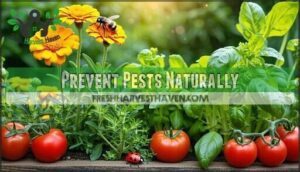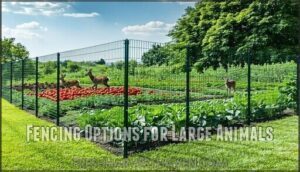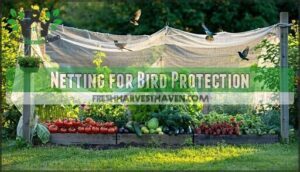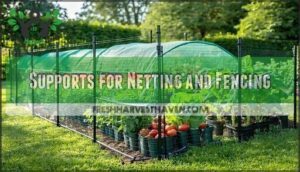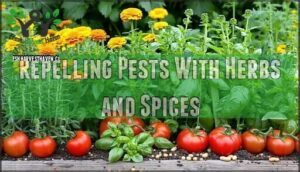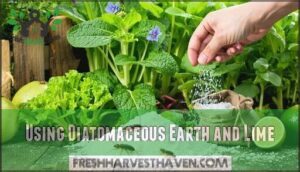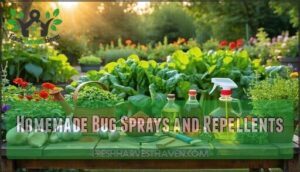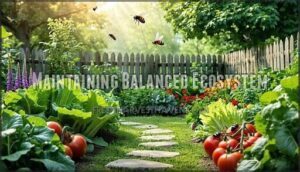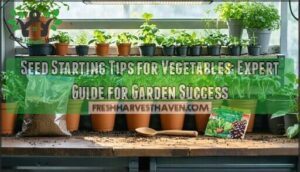This site is supported by our readers. We may earn a commission, at no cost to you, if you purchase through links.
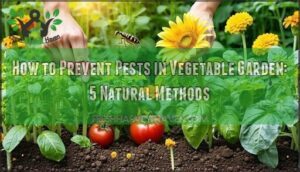 You can protect your vegetable garden from pests by creating a multi-layered defense system that works with nature, not against it.
You can protect your vegetable garden from pests by creating a multi-layered defense system that works with nature, not against it.
Start with physical barriers like row covers, netting, and fencing to block access to your crops.
Deploy natural repellents such as companion plants, essential oils, and homemade sprays made from garlic or soap solutions.
Encourage beneficial insects by planting diverse flowers and herbs that attract predators like ladybugs and lacewings.
Maintain healthy soil through composting and crop rotation to strengthen plant immunity.
Regular garden inspections help you catch problems early before they become infestations.
The secret lies in combining these methods strategically throughout your growing season to achieve a balanced ecosystem and ensure plant immunity, which is key to a successful and healthy garden.
Table Of Contents
- Key Takeaways
- Preventing Garden Pests
- Prevent Pests Naturally
- Creating Physical Barriers
- Natural Pest Control Methods
- Maintaining Balanced Ecosystem
- Frequently Asked Questions (FAQs)
- How do I keep my vegetable garden pest free?
- What is the best pest control for vegetable garden?
- How do I stop bugs from eating my vegetables?
- How do I keep critters out of my vegetable garden?
- How to keep critters out of a vegetable garden?
- What is a natural pest repellent for vegetable gardens?
- How do I stop bugs from eating the leaves of my plants?
- How do I keep bugs away from my vegetable garden?
- What is the best pest control for vegetable gardens?
- How do people control pest problems in vegetable garden?
- Conclusion
Key Takeaways
- Create multiple defense layers – You’ll get the best results by combining physical barriers, such as row covers and fencing, with natural repellents, such as companion plants and homemade sprays, rather than relying on just one method.
- Work with beneficial insects – Plant diverse flowers and herbs to attract ladybugs, lacewings, and other predators that’ll control pests naturally, while avoiding chemicals that harm these helpful allies.
- Monitor your garden regularly – Weekly inspections help you catch pest problems early, before they become serious infestations, making treatment easier and more effective.
- Build healthy soil through composting and crop rotation – Strong, nutrient-rich soil creates resilient plants that naturally resist pest damage and diseases, forming your garden’s foundation for long-term success.
Preventing Garden Pests
Your vegetable garden faces constant threats from insects, animals, and diseases that can destroy months of hard work in just days.
Understanding which pests target your specific crops and implementing natural prevention methods will protect your harvest while maintaining a healthy ecosystem, which is crucial for a successful and healthy garden.
Identifying Common Pests
Your garden’s health depends on catching troublemakers before they multiply. Common garden pests leave distinctive calling cards that make garden pest identification straightforward once you know what to look for.
Signs of garden pests include chewed leaves, sticky honeydew residue, and wilting plants. Pest feeding habits create unique damage patterns—aphids cause leaf curling, while caterpillars leave ragged holes.
Understanding pest life cycles helps you spot problems early, since many vegetable garden pests are most vulnerable during specific stages.
- Aphids cluster on new growth, leaving behind sticky honeydew and curled leaves
- Cabbage worms create perfectly round holes in brassica leaves with dark frass nearby
- Colorado potato beetles show yellow-orange egg masses on leaf undersides before larvae emerge
- Cucumber beetles leave scarred, pitted fruit and wilted vines from bacterial wilt transmission
- Squash vine borers cause sudden wilting with sawdust-like frass at stem bases
Watch for beneficial look-alikes—ladybugs resemble harmful beetles, so proper identification prevents accidentally removing garden allies.
Understanding Pest Damage
Once you’ve spotted those unwelcome visitors, recognizing the telltale signs they leave behind becomes your next detective mission. Pest damage vegetables display specific patterns that help with garden pest identification and reveal your plants’ vulnerability to future attacks.
Damage symptoms aren’t just cosmetic problems—they’re warning signals that affect your harvest’s economic impact. Early pest identification prevents minor issues from becoming major crop losses that’ll leave your wallet lighter.
Different pests create signature calling cards on your plants. Here’s what to watch for:
| Pest Type | Damage Pattern | Risk Level |
|---|---|---|
| Aphids | Yellowing, curled leaves with honeydew | Moderate |
| Caterpillars | Ragged holes, complete defoliation | High |
| Beetles | Skeletonized leaves, root damage | High |
| Borers | Wilted stems, entry holes | Severe |
| Slugs/Snails | Silvery trails, irregular holes | Moderate |
Understanding these signs of garden pests helps you respond quickly. Many pests also act as disease vectors, spreading infections that compound the damage beyond what you initially see on affected foliage.
Importance of Pest Control
Your garden’s ecosystem depends on smart pest control strategies that protect both plants and beneficial insects.
When vegetable garden insects damage your crops, they’re not just nibbling leaves—they’re threatening your family’s food security and your wallet.
Here’s why garden pest prevention matters:
- Crop Health and Food Security – Effective pest control keeps your vegetables thriving and guarantees reliable harvests for your family’s nutrition needs throughout the growing season.
- Economic Impact – Preventing garden pests saves money on replacement plants, seeds, and potential crop losses that can cost hundreds of dollars annually.
- Ecosystem Balance and Human Health – Natural pest control methods preserve beneficial insects while avoiding harmful chemicals that can contaminate your vegetable garden and affect your family’s wellbeing.
Addressing environmental factors such as excessive moisture is also critical for plant health.
Smart garden pest prevention creates a win-win situation where your plants flourish and nature’s helpers stick around.
Prevent Pests Naturally
Working with nature beats fighting it when you’re tackling vegetable garden pests.
Companion Planting creates natural shields—plant marigolds near tomatoes to repel aphids, or basil beside peppers to deter thrips. Crop Rotation breaks pest cycles by moving plant families yearly.
Strong Soil Health builds resilient plants that naturally resist damage. Natural Predators like ladybugs provide ongoing organic pest control when you create welcoming habitats.
Organic Sprays using neem oil disrupt pest life cycles without harming beneficial insects. Utilizing diatomaceous earth application can also dehydrate and eliminate insects.
Natural Method Target Pests
Creating Physical Barriers
Physical barriers serve as your garden’s first line of defense against unwanted visitors, from deer and rabbits to birds and insects.
Installing the right combination of fencing, netting, and support structures can prevent up to 90% of common pest problems without chemicals or harmful treatments, which makes physical barriers a crucial element in garden protection.
Fencing Options for Large Animals
When deer treat your garden like their personal buffet, you need serious protection strategies.
When hungry deer discover your garden oasis, they’ll return nightly until you build proper defenses.
Large animals require different approaches than smaller pests for effective garden pest prevention.
Fence Materials and Height Requirements
- 8-foot minimum height – Deer can’t jump what they can’t clear
- Woven wire fencing – Provides durability while keeping installation costs manageable
- Electric wire additions – Adds extra deterrent power for persistent animals
- Underground barriers – Bury fencing 6 inches deep to stop burrowing creatures
- Secure gate systems – Proper latching prevents easy entry points
Choose materials balancing animal safety with maintenance needs.
Fixed knot woven wire offers excellent protecting vegetable garden solutions without breaking budgets.
Consider companion planting strategies to naturally deter pests near your fence.
Netting for Bird Protection
When feathered visitors threaten your harvest, bird netting provides reliable garden pest control.
Choose fine mesh materials with quarter-inch openings to prevent bird access while allowing sunlight through. Different netting types suit various installation methods – lightweight options for berry bushes, heavier grades for fruit trees.
Understanding bird behavior helps determine timing; install before fruits ripen. Consider different mesh sizes for maximum protection.
While cost analysis shows initial investment, protecting vegetable garden crops pays dividends. This garden pest solutions approach prevents crop loss without chemicals, making it ideal for preventing insect damage and maintaining healthy harvests.
Supports for Netting and Fencing
Your garden’s armor needs solid foundations.
Choose metal fence posts over wooden stakes—they’ll prevent rust and last years longer.
For netting support types, PVC hoops create perfect frames that won’t snap under pressure.
Secure mesh edges with landscape staples or bury them six inches deep to prevent clever critters from sneaking underneath.
Animal barrier heights matter: aim for eight feet against deer, four feet for rabbits.
Consider using durable fence solutions for long-lasting protection.
Select UV-resistant materials that won’t crack after one season of sun exposure, ensuring support structure longevity for effective garden pest prevention.
Natural Pest Control Methods
When pests invade your vegetable garden, you don’t need harsh chemicals to fight back.
Natural pest control methods work effectively while keeping your garden safe for both your family and beneficial insects that help your plants thrive, using natural methods.
Repelling Pests With Herbs and Spices
Herb pest repellents create natural barriers around your vegetable beds.
Plant rosemary near beans to reduce Mexican bean beetles by 40%, while basil interplanted with tomatoes cuts thrips and aphids by 60%.
Marigolds suppress root-knot nematodes, and chives deter carrot flies through sulfur compounds.
These aromatic pest control methods make companion planting pests management effective without chemicals.
Using Diatomaceous Earth and Lime
Two powerhouse ingredients can transform your pest control garden strategy when chemical solutions fall short.
DE Application involves sprinkling diatomaceous earth around plant bases, creating microscopic barriers that damage soft-bodied insects’ exoskeletons. This natural pest control method causes dehydration in aphids, slugs, and beetles while remaining safe for humans and pets.
Lime Benefits extend beyond soil amendment—it deters slugs through rough texture while improving plant health. To further enhance your efforts, consider companion planting benefits by strategically placing certain plants together.
Here’s your action plan:
- Apply DE when dry conditions prevail for maximum effectiveness
- Sprinkle lime around vulnerable plants to create pest-resistant zones
- Wear protective gear during application to avoid respiratory irritation
- Reapply after heavy rain to maintain pest prevention methods
These natural remedies offer dual-purpose garden pest prevention without harsh chemicals.
Homemade Bug Sprays and Repellents
Five DIY recipes offer powerful natural pest control using safe ingredients from your kitchen. These homemade pest spray solutions provide effective pest prevention methods without harsh chemicals.
- Garlic spray – Blend 3 cloves with water, strain, and apply for natural pest repellent
- Soap solution – Mix 2 tablespoons mild dish soap per quart water
- Neem oil blend – Combine 1 tablespoon neem oil with water and soap
- Cayenne pepper mixture – Add 1 teaspoon cayenne to soapy water
- Vinegar treatment – Mix equal parts vinegar and water with soap
Apply these natural remedies during early morning or evening to prevent leaf burn. Consider exploring options for commercial pest solutions if DIY methods are insufficient.
Reapply after rain for spray effectiveness. Store homemade solutions in cool, dark places as storage solutions. Test application methods on small areas first to guarantee plant safety.
Maintaining Balanced Ecosystem
Creating a balanced ecosystem in your garden naturally prevents pest problems by working with nature instead of against it.
When you limit harsh chemicals and encourage beneficial insects while growing diverse crops, you’ll create a self-regulating environment that keeps pest populations in check without constant intervention, by working in harmony with nature.
Limiting Pesticide Use
Chemical pesticides harm beneficial insects and create resistant pest populations over time.
Smart gardeners choose pesticide alternatives that protect their garden’s natural balance. Organic gardening methods work better long-term than synthetic chemicals.
When you must spray, opt for safe application of natural pest repellent like neem oil or targeted sprays with soap solutions for effective pest management garden results.
Chemical Pesticides Natural Alternatives
Encouraging Beneficial Insects
Your garden’s beneficial insects serve as nature’s pest control team, working 24/7 to keep harmful bugs in check.
These natural predators substantially reduce pest populations while supporting healthy vegetable garden care through effective pest management garden strategies.
Attracting Predators requires strategic habitat creation:
- Plant insectary plants like yarrow, dill, and sweet alyssum for pollinator gardens
- Create shallow water sources using ceramic dishes with pebbles
- Establish mulched areas for beneficial insects garden shelter
- Focus on reducing insecticides to protect these valuable pest prevention allies
Planting a Diverse Range of Crops
While beneficial insects patrol your garden, crop rotation and companion planting create confusion for unwanted visitors.
Interplanting colorful varieties like purple cabbage with green plants disrupts pest recognition patterns. Polycultures and agroforestry principles support sustainable gardening through natural diversity.
| Crop Combination | Pest Prevention Benefit | Companion Effect |
|---|---|---|
| Tomatoes + Basil | Repels aphids and hornworms | Enhanced flavor |
| Carrots + Chives | Deters carrot flies | Improved growth |
| Beans + Marigolds | Reduces nematodes | Nitrogen fixation |
| Cabbage + Dill | Controls cabbage worms | Attracts beneficials |
| Corn + Nasturtiums | Traps cucumber beetles | Living mulch |
This ecofriendly pest control approach transforms your space into a balanced ecosystem where pest resistant plants and beneficial insects garden work together, making garden pest control tips unnecessary.
Frequently Asked Questions (FAQs)
How do I keep my vegetable garden pest free?
Ironically, the "pest-free" garden doesn’t exist—nature always finds a way in.
You’ll prevent most problems through companion planting, crop rotation, beneficial insects, row covers, and consistent monitoring for early detection.
What is the best pest control for vegetable garden?
Integrated pest management works best: rotate crops, use companion planting, apply beneficial insects, install row covers, and inspect weekly for early detection and targeted treatment.
How do I stop bugs from eating my vegetables?
Like medieval knights defending their crops, you’ll need strategic defenses. Use row covers, companion planting with marigolds, neem oil sprays, and beneficial insects like ladybugs to protect your vegetables naturally.
How do I keep critters out of my vegetable garden?
Install fencing that’s buried 6-12 inches underground to stop burrowing animals.
Use hardware cloth over raised beds, apply repellent sprays regularly, and remove fallen fruits that attract wildlife to your garden space.
How to keep critters out of a vegetable garden?
Floating row covers block 90% of common garden pests from reaching your vegetables.
Install physical barriers like fencing, netting, or copper tape around beds.
Use companion planting with marigolds to deter insects naturally while maintaining proper spacing.
What is a natural pest repellent for vegetable gardens?
Neem oil spray effectively repels aphids, whiteflies, and caterpillars while being safe for beneficial insects.
Mix with water and apply weekly.
Companion planting with marigolds, basil, and garlic also naturally deters pests.
How do I stop bugs from eating the leaves of my plants?
You’ll want to combine physical barriers with natural deterrents to keep leaf-munching bugs at bay.
Row covers block flying insects, while companion planting with marigolds repels aphids naturally.
Hand-picking larger pests works too.
How do I keep bugs away from my vegetable garden?
You’ll want to create barriers that bugs can’t cross. Row covers block 90% of common pests, while companion planting with marigolds reduces aphid infestations by 30%. Regular inspection catches problems early.
What is the best pest control for vegetable gardens?
Picture your garden as a fortress under siege, with tiny invaders plotting their attack on your precious vegetables.
You’ll master pest control by combining companion planting, beneficial insects, physical barriers, and organic sprays for maximum protection, using companion planting as a key strategy.
How do people control pest problems in vegetable garden?
You control garden pests through multiple strategies: crop rotation, companion planting, beneficial insects, physical barriers like row covers, organic sprays, and regular monitoring to catch problems early.
Conclusion
Success hinges on your commitment to consistent implementation.
You’ve learned how to prevent pests in vegetable garden through physical barriers, natural repellents, and ecosystem balance.
These methods work best when combined strategically throughout your growing season.
Remember that patience pays off—beneficial insects need time to establish themselves, and healthy soil develops gradually.
Start with one or two techniques, then expand your arsenal as you gain confidence.
Your garden’s natural defenses will strengthen with each season, and this is where consistent implementation and healthy soil play a crucial role, leading to a stronger ecosystem balance.

